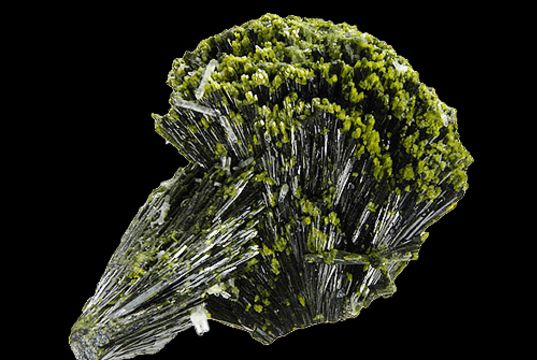Epidote – Mineral and Healing Properties
Chemistry: Ca2(Al, Fe)3(SiO4)3(OH), Calcium Aluminum Iron Silicate Hydroxide.
Class: Silicates
Subclass: Sorosilicates
Group: Epidote
Uses: mineral specimens and rarely as a gemstone.



Epidote is a structurally complex mineral having both single silicate tetrahedrons, SiO4, and double silicate tetrahedrons, Si2O7. The formula of epidote could be expressed in a such a way so as to reflect this organization; Ca2(Al, Fe)Al2O(SiO4)(Si2O7)(OH). The two aluminums represent the parallel chains of AlO6 and AlO4(OH)2 octahedra that are the heart of the epidote structure. The silicate groups and extra ions connect the chains together. Since the chains are parallel, the crystals tend to be prismatic. The chains are arranged in parallel planes and the perfect cleavage breaks the bonds between these planes.
Epidote, while not general known for exceptional crystals can produce some magnificent specimens. Its unique green color which is often described as “pistachio”, is quite striking in well colored specimens.
Origin Of The Name
The name Epidote comes from the Greek words “epi” which means “over” and “didonai” which means “to give”. The name is derived from the Greek word “epidosis” which means “addition.”
Interesting Facts
Epidote was named by Rene Hauy, a mineralogist at the University of Natural History in Paris in the early 1800’s. The name comes from the Greek “epi” for “over” plus “didonai” for “to give” which is supposed to translate roughly as “increase”. This refers to Hauy’s observation that some of the mineral’s prism faces are longer than others.
Where Is It Found
Epidote is an abundant rock-forming mineral, but one of secondary origin. It occurs in marble and schistose rocks of metamorphic origin. It is also a product of hydrothermal alteration of various minerals (feldspars, micas, pyroxenes, amphiboles, garnets, and others) composing igneous rocks. A rock composed of quartz and epidote is known as epidosite. Well-developed crystals are found at many localities: Knappenwand, near the Groávenediger in the Untersulzbachthal in Salzburg, as magnificent, dark green crystals of long prismatic habit in cavities in epidote schist, with asbestos, adularia, calcite, and apatite; the Ala valley and Traversella in Piedmont; Arendal in Norway; Le Bourg-d’Oisans in Dauphin‚; Haddam in Connecticut; Prince of Wales Island in Alaska, here as large, dark green, tabular crystals with copper ores in metamorphosed limestone.
The perfectly transparent, dark green crystals from the Knappenwand and from Brazil have occasionally been cut as gemstones.
Notable Occurrences Untersulzbachtal, Austria; Italy; Baja, Mexico and many localities in the USA.
What Do We Do With It
So far, it has no known uses, other than collecting or gem use.
Metaphysical Uses
Epidote has the ability to clear clutter and confusion from your Heart Energy Center. It acts as a virtual vacuum cleaner, reaching into the hidden corners and crevasses of your emotional body to clean out the cobwebs and dust left behind from memories or experiences where you felt unloved, invisible or abused.
Epidote is an ideal crystal to work with when the majority of healing or releasing has already taken place and you are finally ready to be done with the emotional impact of an experience. Epidote offers the finishing touches or final release. As a result, there are ceremonial energies associated with Epidote. The ceremonies or rituals that we create to symbolize events of demarcation are sometimes the most important touchstone we have for those events. The creation and participation in these ceremonies are the anchors of your intentions and the basis of how you will reflect on them in the future.
Graduations, marriage, funerals, showers, burning bowls, medicine wheels, et cetera. , helping you let go of an old story, offering the final healing of an old wound and forgiveness for the human experience.
Epidote can help you to tap into the energies of the support structures that are already around you. If you tend to isolate yourself from receiving help and live independently, Epidote can be a powerful ally to help you notice the people, organizations and services that are available to assist you. When you recognize resources for the support that they offer and your role in allowing them into your life, you will realize that leaning on others during times of need doesn’t mean that you give your power away it means that you claim your power. Epidote is a good tool for identifying and releasing martyr energies.
Physical Characteristics
Color: “pistachio” green to yellowish or brownish green, also brown to black.
Luster: Vitreous.
Transparency: Crystals are transparent to translucent.
Crystal System: Monoclinic; 2/m
Crystal Habits: Long, somewhat prismatic or tabular crystals with a typically dominant pinacoid that the crystal is often flattened against. The terminations are wedge shaped or tapered pyramids. Many clusters show grooved slender crystals or acicular sprays. Also massive, fiberous or granular.
Cleavage: Good in one direction lengthwise.
Fracture: Uneven to conchoidal.
Hardness: 6 – 7
Specific Gravity: 3.3-3.5
Streak: White to gray
Associated Minerals: Calcite, biotite, hornblende, actinolite, andradite garnet and other metamorphic minerals.
Other Characteristics: Striated to the depth of grooves in some crystals.
Best Field Indicators: Only one direction of cleavage, crystal habit, color and hardness.


